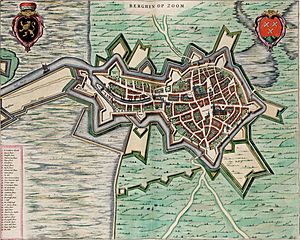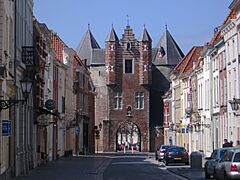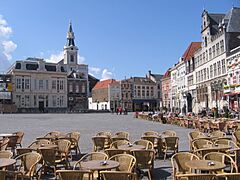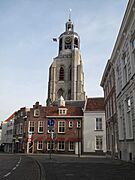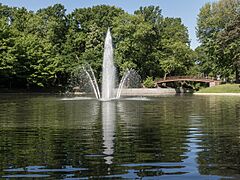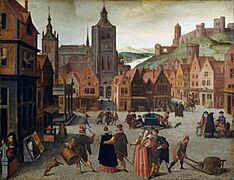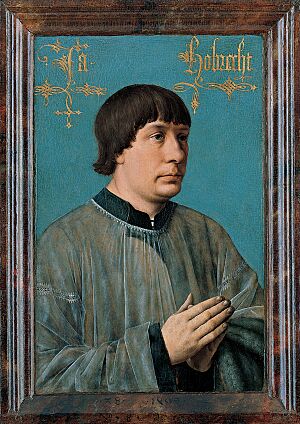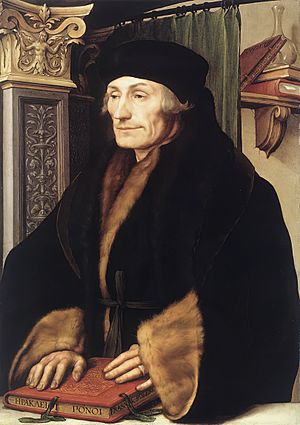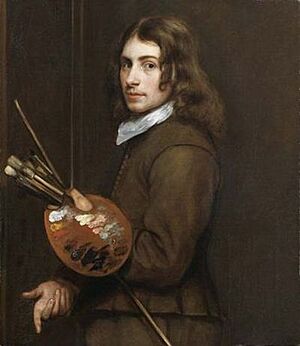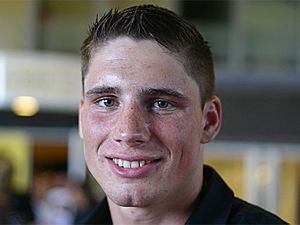Bergen op Zoom facts for kids
Quick facts for kids
Bergen op Zoom
|
|||
|---|---|---|---|
|
City and municipality
|
|||

Markiezenhof in Bergen op Zoom
|
|||
|
|||
| Anthem: Merck toch hoe sterck | |||
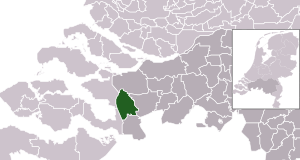
Location in North Brabant
|
|||
| Country | Netherlands | ||
| Province | North Brabant | ||
| Government | |||
| • Body | Municipal council | ||
| Area | |||
| • Total | 93.13 km2 (35.96 sq mi) | ||
| • Land | 80.04 km2 (30.90 sq mi) | ||
| • Water | 13.09 km2 (5.05 sq mi) | ||
| Elevation | 10 m (30 ft) | ||
| Population
(May 2014)
|
|||
| • Total | 66,464 | ||
| • Density | 830/km2 (2,100/sq mi) | ||
| Demonym(s) | Bergenaar | ||
| Time zone | UTC+1 (CET) | ||
| • Summer (DST) | UTC+2 (CEST) | ||
| Postcode |
4600–4625, 4660–4664
|
||
| Area code | 0164 | ||
Bergen op Zoom is a city and municipality in the southwestern Netherlands. It is located in the province of North Brabant. This city is close to the border with Zeeland. In January 2021, about 67,514 people lived in the municipality. The local people sometimes call the city Berrege.
Contents
What's in a Name?
The name of Bergen op Zoom tells us about the land it's built on. The city sits where two types of soil meet. One is sandy soil, and the other is marine clay. Over many centuries, the sandy soil pushed up against the clay. This created hills, which people called the Brabantse Wal. This means "ramparts of Brabant".
The word Bergen in Dutch means "mountains" or "hills". The word Zoom refers to the edge or border of these hills. So, the name describes the city's location at the edge of these natural hills. It's interesting to know that the name has nothing to do with a small canal called the Zoom, which was built later.
A Look Back: History of Bergen op Zoom
Bergen op Zoom likely became a city around the year 1212. In 1287, the city and its surrounding area became a special territory called a lordship. This meant it was separate from the lordship of Breda. Later, in 1559, this lordship became even more important and was called a margraviate.
Different noble families ruled Bergen op Zoom until 1795. One important family was the House of Glymes. Even though they held the title, their power was mostly symbolic after the 1600s.
A Strong Fortress City
For a long time, Bergen op Zoom was a very strong fortress. It was one of the main places where the United Provinces kept their weapons and supplies. The city had a great natural defense. It was surrounded by marshes and lands that could be easily flooded. This made it hard for enemies to attack. Also, the city could get help and supplies by sea. This was a big advantage unless the enemy had a strong navy.
Because of its strong defenses, Bergen op Zoom was a key city for the Dutch during the Eighty Years War. This war began in the late 1500s. The city was attacked twice during this war. First, Alessandro Farnese tried to capture it in 1588. Then, Ambrosio Spinola tried again in 1622. Both attacks failed. Because it was never successfully captured, Bergen op Zoom earned the nickname La Pucelle, meaning "The Virgin".
In 1747, during the War of the Austrian Succession, the French army attacked the city. Bergen op Zoom had new defenses built by Menno van Coehoorn. These included three forts around the city and a canal that acted like a moat. However, the city didn't have a second line of defense. After seventy days of fighting, the French took the city. They looted it, and many soldiers defending the city were killed.
Later, in 1814, during the War of the Sixth Coalition, the British also tried to capture the city. But they failed to remove the French soldiers who were defending it.
A Busy Trading Town
During the rule of Jan II van Glymes (1417–1494), the city's economy grew a lot. Jan was nicknamed "Jan with the big lips." Large fairs were held twice a year, in spring and fall. These fairs were famous across Europe. Merchants from many countries came to Bergen op Zoom to sell their goods.
Because of this growth, the Sint-Gertrudischurch was made bigger. This new part was called the Nieuw Werck. However, it was never finished. The city's economy slowed down in the mid-1500s. This was mainly because the port became harder to reach due to floods. Since the city relied heavily on its port, this hurt its economy. Also, new ways of trading, like permanent stock exchanges instead of just fairs, also affected the local economy.
The big fairs continued until 1910. Even though the large fairs ended, Bergen op Zoom still hosts many smaller fairs and events today.
Religion in the City
During the Eighty Years' War, Bergen op Zoom supported the Dutch Republic. This also meant the city became Protestant. Many Catholics either changed their religion or moved to the nearby countryside, which remained mostly Catholic. Those who stayed Catholic in the city had to hold church services secretly in barns and houses. This was because the main church, Sint-Getrudischurch, was given to the Protestant community.
Over time, most city leaders in Bergen op Zoom were Protestant. This lasted until the 1700s. After that, more and more Catholics moved back to the city. By the late 1700s, most people in Bergen op Zoom were Catholic again. Catholics gained more religious freedom when the French ruled from 1795 to 1814. But they didn't get full equal rights until later.
In 1832, a Catholic church was allowed to have its own building. Around the same time, the Jewish community built their own synagogue.
In 1972, the Protestant community, which had fewer members by then, gave the Sint-Getrudischurch back to the Catholic church. Since then, Catholic services have been held there again.
Today, Bergen op Zoom also has a notable Muslim community. This is due to immigration from countries like Turkey and Morocco to the Netherlands.
Areas in Bergen op Zoom
- Bergen op Zoom (population: 65,691, July 2006)
- Heimolen
- Halsteren (11,410)
- Lepelstraat (2,070)
- Kladde
What to See in Bergen op Zoom
The Markiezenhof Palace is a beautiful building from the 1400s and 1500s. It now serves as a cultural center and a museum. You can explore its lovely courtyard, see old paintings, and visit rooms that show how people lived long ago. The museum also hosts special temporary exhibitions.
Some large companies have facilities in Bergen op Zoom. SABIC Innovative Plastics has a big manufacturing plant here. Philip Morris was also a major employer until its factory closed in 2014.
Getting Around
- Bergen op Zoom railway station is the city's train station.
Famous People from Bergen op Zoom
Many talented people have come from Bergen op Zoom, including:
Artists and Thinkers
- Jacob Obrecht (1457–1505) – A composer known for his sacred music.
- Desiderius Erasmus (1466–1536) – A famous thinker, philosopher, and writer.
- Abel Grimmer (1570–1619) – A Flemish painter, mostly known for landscapes.
- Gerrit Houckgeest (1600–1661) – A Dutch painter of buildings and church interiors.
- Thomas Willeboirts Bosschaert (1613–1654) – A Flemish Baroque painter.
- Anton van Duinkerken (1903–1968) – A Dutch poet and essay writer.
- Pleuni Touw (born 1938) – A Dutch actress in film, TV, and theater.
- Cornald Maas (born 1967) – A Dutch television presenter.
- Julia Boschman (born 2002) – A Dutch singer in the popular girl group K3.
Public Service and Sports
- Pieter Gerardus van Overstraten (1755–1801) – The last Governor-General of the Dutch East Indies.
- Ed Nijpels (born 1950) – A Dutch politician.
- Paul Schnabel (born 1948) – A Dutch sociologist and politician.
- Reindert de Favauge (1872–1949) – A sport shooter who competed in the Olympics.
- Henk Kersken (1880–1967) – A sailor who competed in the Olympics.
- Rico Verhoeven (born 1989) – A well-known kickboxer.
- Oussama Idrissi (born 1996) – A professional footballer.
Sister Cities
Bergen op Zoom has "sister city" relationships with other towns. This helps them share culture and ideas.
 Oudenaarde, Belgium
Oudenaarde, Belgium Szczecinek, Poland
Szczecinek, Poland
|
See also
 In Spanish: Bergen op Zoom para niños
In Spanish: Bergen op Zoom para niños






